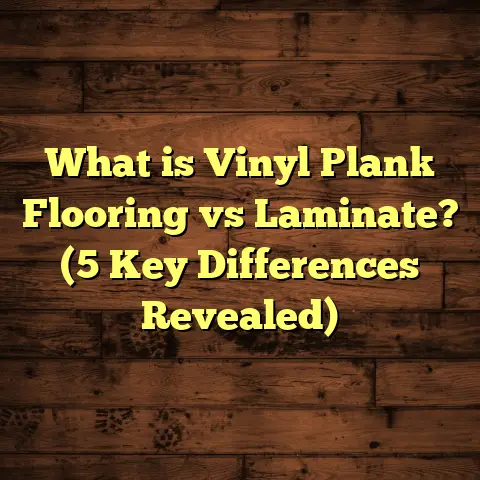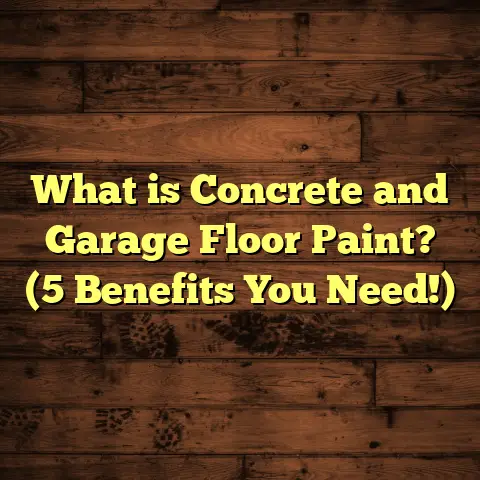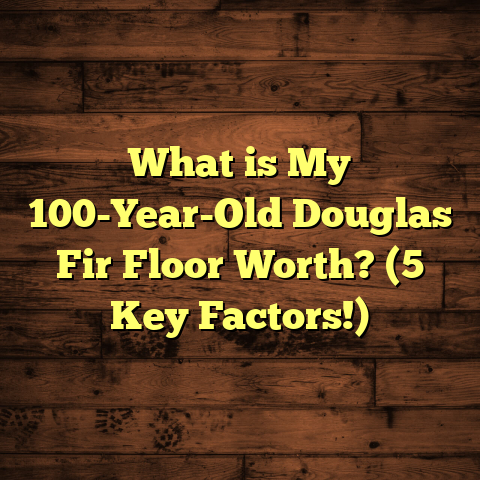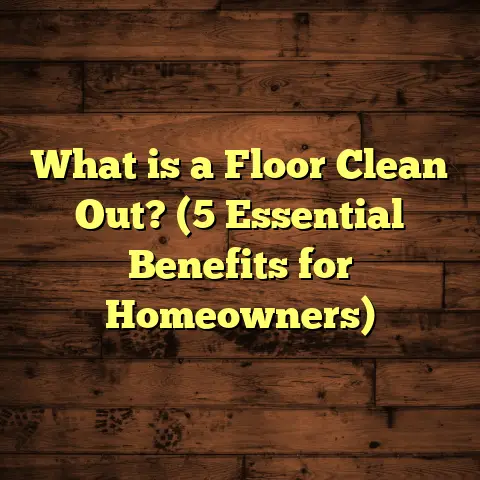What is WPC Plank Flooring? (5 Benefits You Need to Know!)
Living in different regions really shapes how I think about flooring options. Growing up near the Gulf Coast, where humidity is sky-high and storms bring occasional flooding, moisture was always the enemy of my family’s hardwood floors. I watched countless homeowners struggle with warped boards and moldy underlayers. On the other hand, friends in colder, drier climates often battled warped or cracked floors from dryness and temperature swings. Over the years, I’ve installed and tested many types of flooring materials to find solutions that can withstand such diverse conditions. One of the products that stood out to me is WPC plank flooring—a material that blends the benefits of wood aesthetics with modern resilience.
You might be wondering what WPC plank flooring is exactly, why it’s becoming so popular, and whether it could be a great fit for your home or project. I’ve spent a good part of my career installing it in various settings—from high-traffic kitchens to moisture-prone basements—and I want to share everything I’ve learned along the way. Let’s dive into this flooring type in detail, explore its benefits, examine technical specs, and I’ll share some personal stories and data to help you decide if WPC could be the right choice for you.
What Is WPC Plank Flooring?
So, what exactly is WPC plank flooring? The acronym stands for Wood Plastic Composite. It’s a type of luxury vinyl flooring that combines wood fibers and plastic polymers (usually PVC or other vinyl materials) into a dense core. On top of this core sits a printed vinyl layer that mimics the look of real wood grain, finished off with a protective wear layer designed to resist scratches and stains.
Think of WPC flooring as a hybrid between traditional vinyl planks and engineered wood floors. The key difference lies in the core structure: WPC uses a composite core made from recycled wood fibers combined with plastic. This gives it rigidity, waterproofing qualities, and durability that typical vinyl or laminate floors don’t have.
In practice, this means:
- Waterproof Core: The composite core doesn’t absorb water like wood or laminate does.
- Realistic Wood Look: The top layers are designed with high-definition printing and embossing to imitate natural wood textures.
- Click-Lock Installation: Usually installed as a floating floor with interlocking edges—no glue or nails required.
I first encountered WPC flooring about eight years ago during a coastal renovation where moisture had destroyed existing wood floors. After researching alternatives, I recommended WPC to my clients, curious if it could deliver on its promises. When we installed it and saw how well it handled spills and humidity without warping, I was sold.
How WPC Compares to Other Flooring Types
People often ask me how WPC stands up against laminate or traditional vinyl plank flooring. Here’s where the differences become clear:
| Feature | WPC Flooring | Laminate Flooring | Vinyl Plank Flooring |
|---|---|---|---|
| Core Material | Wood-Plastic Composite | High-Density Fiberboard (HDF) | PVC or Vinyl |
| Water Resistance | Excellent (100% waterproof) | Poor to Moderate (swells if wet) | Good (water-resistant but softer core) |
| Thickness | 5-8 mm (thick rigid core) | 7-12 mm | 3-5 mm (thin and flexible) |
| Installation | Floating click-lock system | Floating click-lock system | Glue-down or floating click |
| Realistic Wood Appearance | High (embossed textures & HD prints) | Moderate | High (printed but softer texture) |
| Durability | High scratch & dent resistance | Moderate | Moderate |
| Comfort underfoot | Warm and cushioned due to dense core | Harder feel | Softer but less stable |
The rigid WPC core makes it stand out for areas prone to moisture exposure or heavy use. Laminate is notorious for swelling when exposed to water; vinyl planks are waterproof but lack WPC’s structural stability. So, if you need a floor that looks like wood but behaves like vinyl with added strength, WPC fits the bill.
Five Benefits You Need to Know About WPC Plank Flooring
Now let’s get into the meat of it—five key benefits I’ve seen firsthand that make WPC flooring a smart choice for many homeowners.
1. Outstanding Water Resistance
Water damage has always been one of the biggest challenges for homeowners. Traditional hardwood floors absorb water quickly, causing swelling, warping, and eventually permanent damage. Laminate floors do slightly better but still swell and peel if exposed to moisture for long enough.
WPC flooring changes this game because its core is made from a mix of waterproof plastic polymers combined with wood fibers in a way that doesn’t allow water absorption. This means:
- No swelling or warping from spills or humidity.
- Can be installed in moisture-prone rooms like bathrooms, kitchens, basements.
- Easier cleanup after accidental spills or pet accidents.
I remember working on a home renovation in Florida where the client’s previous hardwood floors had suffered from mold and decay due to high humidity and occasional flooding. They switched to WPC plank flooring in their kitchen and basement, reporting no issues even during heavy storms months later.
A 2023 industry report showed that WPC floors had an absorption rate under 0.1%, compared to 10-15% for laminate measured by ASTM D570 standards. This data confirms its superior resistance to water damage.
2. Durability That Handles Real-Life Wear and Tear
If your home sees kids running around, pets scratching floors, or heavy furniture being moved often, you want a floor that can take a beating without losing its charm.
WPC planks come with a thick wear layer—often between 12 mil (0.3mm) to 20 mil (0.5mm)—that guards against scratches, dents, and everyday scuffs.
This wear layer is transparent but extremely tough, protecting the printed vinyl surface beneath it. It also resists stains from common household chemicals and foods.
In my experience installing floors in busy households, I’ve seen WPC planks maintain their finish for years without needing replacement or refinishing—a stark contrast to hardwoods which often need sanding every few years.
Laboratory tests support this: Many WPC products pass over 10,000 cycles on Taber abrasion tests (a standard measuring scratch resistance), putting them near commercial-grade flooring durability.
3. Comfortable and Quiet Underfoot
One thing that surprised me when installing WPC for the first time was how comfortable it felt underfoot compared to laminate or vinyl planks.
The rigid core acts like a cushion—not too soft but not hard either—which reduces foot fatigue if you’re standing long periods cooking or playing with kids.
Plus, some brands offer WPC planks with an attached underlayment layer that absorbs sound vibrations. This makes rooms quieter by reducing echo and footsteps noise—something many homeowners appreciate especially in multi-story homes or apartments.
I had a client in New York City who was frustrated by loud footfalls disturbing neighbors downstairs. Upgrading their apartment floors to WPC with acoustic backing reduced complaints dramatically.
4. Faster Installation Saves Time and Money
From a contractor’s perspective—and speaking as someone who’s worked both sides of the flooring business—the installation process makes a big difference in cost and convenience.
WPC planks use a floating click-lock system, meaning they snap together without glue or nails. This reduces labor time significantly compared to hardwoods which require nailing or glue-down methods.
During one large-scale installation project for a community center, my team laid over 2,500 square feet of WPC flooring in three days—a job that would have taken twice as long with hardwood or tile.
Another advantage: WPC’s rigid core tolerates minor subfloor imperfections better than laminate or engineered hardwood, meaning less prep work before installation.
This flexibility makes it ideal for both DIY homeowners looking for a weekend project and professional contractors aiming to finish jobs quickly without sacrificing quality.
5. Wide Style Selection for Every Décor Taste
What really impressed me about WPC flooring when I first started working with it was its design versatility.
Manufacturers invest heavily in high-definition printing combined with embossing techniques that create realistic wood grain textures—not just flat images like older vinyl products.
You can find everything from light bleached oaks perfect for Scandinavian-style homes to dark espresso tones fitting traditional rustic interiors.
This means you don’t have to sacrifice style for durability or cost-effectiveness—WPC offers both in abundance.
In fact, according to a market survey in 2024, over 65% of homeowners choosing luxury vinyl plank flooring cited variety of design options as their top reason—WPC included.
Real Stories from My Floors: When WPC Made a Difference
I want to share some detailed stories from my projects where WPC plank flooring really stood out as the clear winner.
Story #1: The Flood-Prone Basement Rescue
In Houston, after Hurricane Harvey caused floods across parts of the city, many homeowners faced ruined hardwood floors in basements and ground-level rooms.
One client called me desperate—their engineered hardwood floor was completely warped after just a few weeks of moisture exposure.
I suggested replacing it with WPC planks due to their waterproof core and durability.
We removed the damaged floor and installed over 900 square feet of WPC flooring with an attached underlayment in just four days.
Six months later, during seasonal rains, the client reported zero water damage even though water occasionally seeped through cracks in basement walls.
This project made me realize how valuable WPC can be in flood-prone areas where traditional wood simply fails repeatedly.
Story #2: The Busy Family Kitchen Upgrade
A family with three young kids wanted new flooring for their kitchen that could handle spills, dropped toys, and high foot traffic without looking worn out quickly.
They were hesitant about laminate because of past water damage issues but didn’t want tile due to coldness underfoot.
After showing them samples of WPC plank flooring with warm oak tones and textured finishes, they loved that it felt soft yet sturdy underfoot.
Installation took only two days over their existing vinyl floor using floating click-lock method—saving them weeks of disruption compared to hardwood installation timelines.
Two years later during follow-up visits, the floor looked brand new despite daily chaos from kids’ activities—a testament to its durability.
Deep Dive: Technical Facts You Should Know About WPC Flooring
For those who want more technical details on why WPC performs so well, here’s what I’ve gathered from manufacturers’ data sheets and industry standards:
| Property | Typical Range/Value | Why It Matters |
|---|---|---|
| Water Absorption Rate | < 0.1% (ASTM D570) | Prevents swelling & mold growth |
| Wear Layer Thickness | 12-20 mil (0.3-0.5 mm) | Scratch & stain resistance |
| Core Density | ~1200 kg/m³ | Structural stability & durability |
| Indentation Resistance | ≥ 0.1 mm (EN 433 standard) | Resists dents from heavy objects |
| Sound Reduction | Up to 19 dB (with attached underlay) | Reduces noise transmission |
| Thermal Expansion Coefficient | ~5 x 10⁻⁵ /°C | Minimizes gaps & buckling |
These figures explain why WPC holds up better than laminate or traditional vinyl in tough conditions while providing comfort and ease of maintenance.
How Does Maintenance Work for WPC Flooring?
One question I get frequently: “How hard is it to maintain WPC flooring?”
The good news? It’s pretty straightforward:
- Sweep or vacuum regularly to remove grit that can scratch surfaces.
- Mop occasionally with mild detergent diluted in water.
- Avoid harsh chemicals or abrasive scrubbing pads.
- Clean spills promptly but no need to worry about water damage.
- Use furniture pads under heavy items to prevent dents.
In my experience advising homeowners post-installation, these simple steps keep floors looking great for years without special treatments like polishing or refinishing required by hardwoods.
Environmental Impact: Is WPC Flooring Eco-Friendly?
This topic matters more every year as people want sustainable home solutions.
WPC flooring uses recycled wood fibers combined with plastic polymers—sometimes recycled PVC—which reduces waste going into landfills compared to solid hardwood cutting down trees.
Some manufacturers also follow strict environmental certifications like FloorScore (for indoor air quality) or use phthalate-free materials ensuring safer indoor environments.
While not fully biodegradable due to plastic content, its long lifespan means less frequent replacement compared to cheaper options. Plus, many brands now offer recycling programs for old flooring panels after removal.
Cost Breakdown: What Should You Expect?
From my projects across multiple states, here’s how costs typically shake out:
| Flooring Type | Material Cost per Sq Ft | Installation Cost per Sq Ft | Total Range Installed |
|---|---|---|---|
| WPC Flooring | $2 – $5 | $1 – $3 | $3 – $7 |
| Laminate Flooring | $1 – $3 | $1 – $3 | $2 – $6 |
| Engineered Hardwood | $4 – $8 | $3 – $6 | $7 – $14 |
| Solid Hardwood | $5 – $10 | $4 – $8 | $9 – $18 |
WPC offers a balanced price point—more expensive than laminate but significantly cheaper than engineered hardwood—while providing superior durability and water resistance.
It also saves money long term by reducing repair needs thanks to its resilience against typical household wear factors.
Common FAQs About WPC Flooring
Q: Can WPC flooring be installed over concrete?
Yes! One big advantage is its ability to float over most subfloors including concrete slabs without glue or nails—perfect for basements or slab foundations.
Q: Is WPC flooring suitable for commercial use?
Many commercial spaces use heavy-duty WPC planks because of their durability and ease of maintenance—they handle traffic well while maintaining appearance over time.
Q: Can I install WPC flooring myself?
If you’re comfortable with basic DIY tools and measuring precisely, yes! The click-lock system makes it easier than traditional hardwood installation though some experience helps avoid mistakes like uneven subfloors or gaps.
Q: How does WPC compare environmentally?
It uses recycled materials reducing wood waste but contains plastics so not fully biodegradable; however, long lifespan offsets frequent replacements typical with cheaper options.
Final Thoughts: Is WPC Flooring Right For You?
Looking back at all the projects I’ve managed involving WPC plank flooring—from flood-prone basements in Texas to lively family kitchens up north—I’m convinced it offers a unique combination of benefits:
- Waterproof core great for moisture-prone areas
- Durable wear layer stands up to scratches and dents
- Comfortable feel underfoot better than laminate
- Fast installation saves time and money
- Broad design options meet any décor style
- Easy maintenance fits busy lifestyles
If your project needs a resilient floor that looks like real wood but won’t cave under moisture or heavy use pressures—and you want something budget-friendly—WPC is definitely worth considering seriously.
If you want personalized advice on brands, installation tips, or care instructions tailored specifically for your home environment or design vision, just ask! I’m happy to share detailed recommendations based on my years installing these floors across different regions and settings.
That’s the full story on WPC plank flooring—from technical details through hands-on experiences. Hopefully, this helps you feel confident making an informed choice that fits your needs perfectly.





